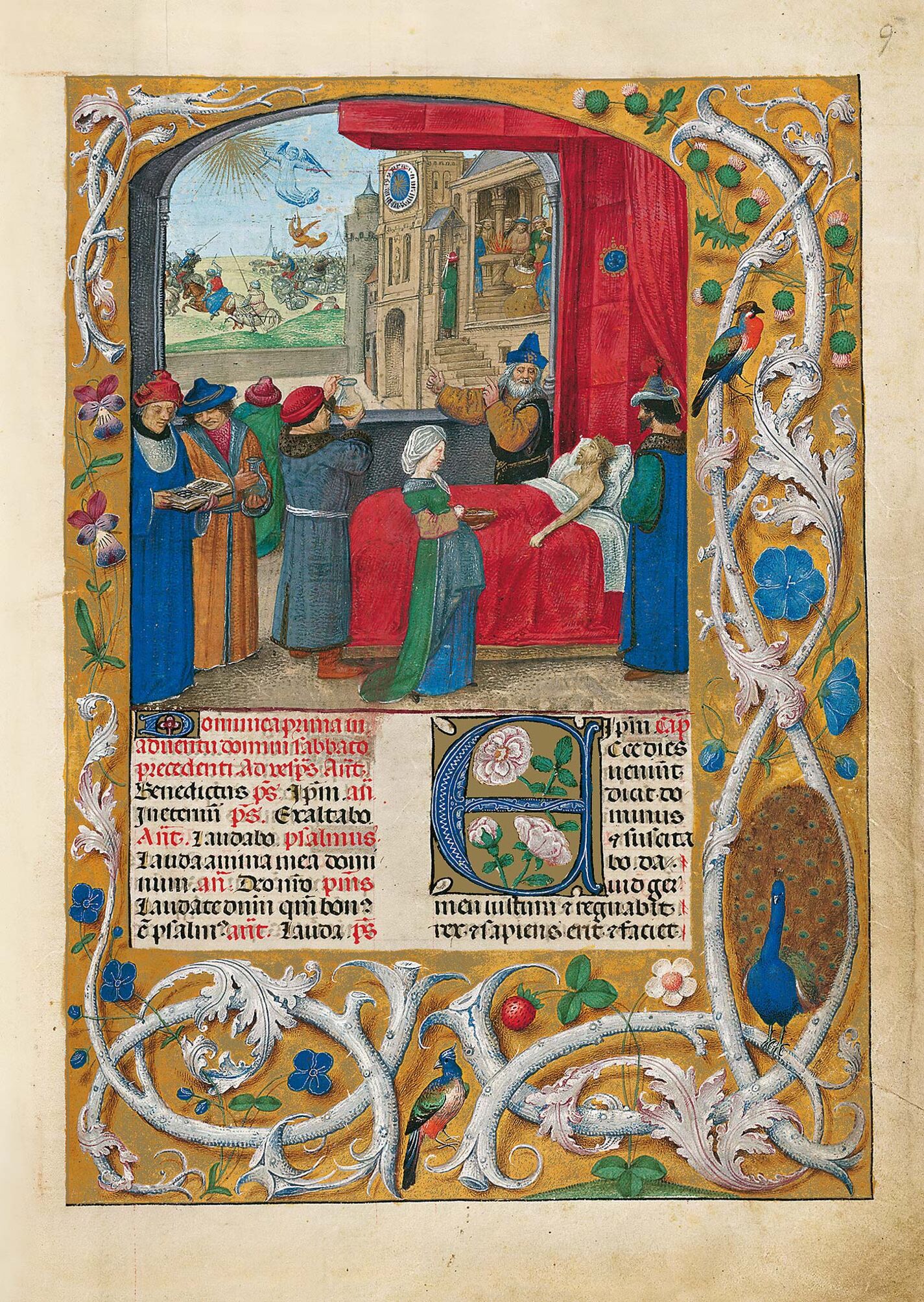A twenty-four line miniature over both columns of text of David on his deathbed, surrounded by attendants and a doctor examining a urine flask. David is recalling how he built the first altar on the site of the Temple, after God had spared Jerusalem from the pestilence sent to punish his sin of pride, and is shown by a prophet a vision of an age of peace and justice as the strife of war is overcome, who stands by the bed pointing to the outside cityscape and landscape, possibly also illustrating the messianic prophecy of the Capitulum (Jer 23 v. 5): “Behold the days come, saith the Lord, and I will raise up to David a just branch. And a king shall reign, and shall be wise, and shall execute judgement and justice in the earth”.
In the city is the Temple of Jerusalem in which David kneels before an altar on which a burnt sacrifice is offered. In the landscape there is a battle scene with an angel wielding a sword over the army. In the sky above beside the sun another angel extends his arms over the scene of strife below. This subject is unique among those used in other Flemish breviaries for the opening of Advent. The liturgy of the day is about the coming of the Messiah, and this is conveyed sometimes by Israelites as a group beseeching God to send the Messiah, as in the Grimani Breviary, or the Tree of Jesse, according to the prophecy of Isaiah, as in the Breviary of Philip the Good. In the Dominican rite the Gospel reading for the Mass of the day was Mt 21 vv. 1-9 which narrates the Entry of Christ into Jerusalem, and in the Roman/Franciscan rite at Matins of Advent Sunday the invitatory and antiphon for the psalms of the first nocturn paraphrase Mt 21 v. 5 “Behold thy king cometh unto thee” from the account of the Entry into Jerusalem. The Breviary of Eleanor of Portugal (New York, Morgan Library & Museum, M. 52) therefore uses the Entry into Jerusalem as a frontispiece miniature to the opening of the First Sunday of Advent. It is difficult to understand why the scene of the dying David is illustrated in the Isabella Breviary, although later in the book in the Psalter section, there is a great interest in scenes of David’s life, in part derived from Nicholas of Lyra’s Commentary on the Psalms. Possibly the person, perhaps a Dominican, who advised the artists on the illustrations had a particular interest in David, and maybe this subject for the First Sunday of Advent might have derived from a passage in Nicholas of Lyra’s commentary.
There is a full border of the first category on a gold-yellow ground strewn with silver-white acanthus leaves and branches, flowers, fruit and three birds, one a peacock; an eight-line initial containing flowers introduces the Capitulum for First Vespers.

A twenty-four line miniature over both columns of text of David on his deathbed, surrounded by attendants and a doctor examining a urine flask. David is recalling how he built the first altar on the site of the Temple, after God had spared Jerusalem from the pestilence sent to punish his sin of pride, and is shown by a prophet a vision of an age of peace and justice as the strife of war is overcome, who stands by the bed pointing to the outside cityscape and landscape, possibly also illustrating the messianic prophecy of the Capitulum (Jer 23 v. 5): “Behold the days come, saith the Lord, and I will raise up to David a just branch. And a king shall reign, and shall be wise, and shall execute judgement and justice in the earth”.
In the city is the Temple of Jerusalem in which David kneels before an altar on which a burnt sacrifice is offered. In the landscape there is a battle scene with an angel wielding a sword over the army. In the sky above beside the sun another angel extends his arms over the scene of strife below. This subject is unique among those used in other Flemish breviaries for the opening of Advent. The liturgy of the day is about the coming of the Messiah, and this is conveyed sometimes by Israelites as a group beseeching God to send the Messiah, as in the Grimani Breviary, or the Tree of Jesse, according to the prophecy of Isaiah, as in the Breviary of Philip the Good. In the Dominican rite the Gospel reading for the Mass of the day was Mt 21 vv. 1-9 which narrates the Entry of Christ into Jerusalem, and in the Roman/Franciscan rite at Matins of Advent Sunday the invitatory and antiphon for the psalms of the first nocturn paraphrase Mt 21 v. 5 “Behold thy king cometh unto thee” from the account of the Entry into Jerusalem. The Breviary of Eleanor of Portugal (New York, Morgan Library & Museum, M. 52) therefore uses the Entry into Jerusalem as a frontispiece miniature to the opening of the First Sunday of Advent. It is difficult to understand why the scene of the dying David is illustrated in the Isabella Breviary, although later in the book in the Psalter section, there is a great interest in scenes of David’s life, in part derived from Nicholas of Lyra’s Commentary on the Psalms. Possibly the person, perhaps a Dominican, who advised the artists on the illustrations had a particular interest in David, and maybe this subject for the First Sunday of Advent might have derived from a passage in Nicholas of Lyra’s commentary.
There is a full border of the first category on a gold-yellow ground strewn with silver-white acanthus leaves and branches, flowers, fruit and three birds, one a peacock; an eight-line initial containing flowers introduces the Capitulum for First Vespers.